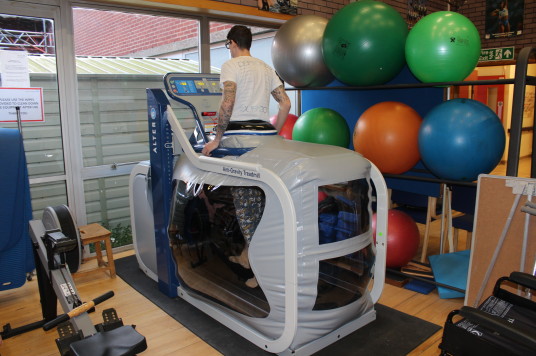Nick’s moonwalk to recovery
Nick was brought to St George’s A&E after being involved in a motorbike accident. X-rays showed that he had fractured his leg in two places and broken his collar bone. The nature of Nick’s injuries meant that he needed physiotherapy to start walking again.
Usually this process would be achieved through teaching Nick how to use sticks and frames to mobilise and build his confidence in walking appropriately on his injured leg. However, Nick’s broken collar bone meant that he was unable to support himself using a stick or a walking frame.
In the past patients with Nick’s type of injuries would need to stay off their broken leg until they had the capacity to use an aid. It would be a slow recovery process and could sometimes mean a lengthy hospital stay if they were unable to cope at home.
In December 2014 St George’s purchased an anti-gravity treadmill to help better treat patients like Nick. The machine is designed to enable patients to exercise at reduced gravity meaning there is less weight being placed on their injured limb. It can be set-up anywhere between 20-100% gravity with 20% being likened to walking on the moon.
Nick was the first patient at St George’s to use this specialised treadmill. His physiotherapist, Lucy had received two weeks of training in how to use it and she felt it was the perfect answer to his rehabilitation needs.
Arriving in the gym in a wheelchair Nick was placed into some custom shorts which are then zipped into the lining of the treadmill so that it can calibrate, ready for a workout. Once ready Lucy can set the percentage of gravity she feels it is appropriate for Nick to walk at. This can be adjusted at anytime during the session meaning he can be eased in at much reduced gravity and then challenged if ready.
Nick still felt some discomfort when walking on his leg but this was greatly reduced. He told us how the treadmill had helped to show him just how far his recovery had come. When he first started his rehabilitation he was walking at a much reduced gravity setting and through his sessions he has seen that increase, which was helping him to get his confidence back and he now felt ready to cope at home.
Lucy Coughlan, Highly Specialised Physiotherapist at St George’s said: “We are delighted with the new anti-gravity treadmill, we envisage that it will open up new opportunities in rehabilitating our trauma patients and will allow patients with complex injuries or multiple fractures to start walking much sooner than was previously possible.
“There are huge benefits to being able to offload up to 80% of your body weight – it can help with pain, reduce strain on the legs and because you don’t need to support yourself with your arms people with upper limb injuries can also be accommodated.
“We are very excited to be able to use this treadmill as one of our many tools in helping people return to function, work and sport after injury.”
St George’s is the seventh NHS Hospital to purchase an anti-gravity treadmill. It cost £40,000, which was achieved through fundraising efforts and Sky 1’s payment for their ‘Critical’ bootcamp.


